The Ultimate Guide to Successful Facebook Video Ads
Contents
Facebook is the largest social media platform in the world, with over 2.38 billion monthly users.
This means it offers brands unparalleled opportunities for reaching and interacting with HUGE audiences.
Facebook is also a popular place for consumers to learn more about new brands. In fact, 55% of users consider it the most common platform to discover new products. So clearly, if you’re not using Facebook to share content with your audience, you’re missing out.
But there is one small problem.
Unfortunately, statistics show that the average organic reach of a brand’s Facebook posts is only 6.4% of their page’s total likes. This means your brand’s regular Facebook content is probably reaching only a small portion of your entire following.
Don’t worry though, the solution is simple. Promote your content with Facebook ad campaigns.
And what better way to drive up viewership and engagement than by sharing consumers’ #1 favourite type of branded content — videos.
But with so many users and brands, it can be difficult to share video content that really stands out. That’s exactly why we made this comprehensive guide with everything you need to know to kickstart your own stellar Facebook video ads campaign.
In this article, we’ll cover:
- Facebook video ad formats
- Facebook video ad specs
- The 16 BEST practices to optimize your Facebook video ads campaign
- The best Facebook video ads for inspiration
So let’s get started!
Facebook Video Ad specs & formats
Facebook supports a huge range of marketing objectives and offers a number of different ad formats to choose from. There’s bound to be something out there for everyone!
But with so many options available, Facebook video ads can sometimes get confusing.
You might be asking yourself, “how long can Facebook video ads be?” and “what kind of video ads can you make for Facebook?”
Don’t worry. We’ve got you covered. Let’s take a look at all the Facebook video ad formats and video ad specs you need to know!
1. In-feed Video Ads
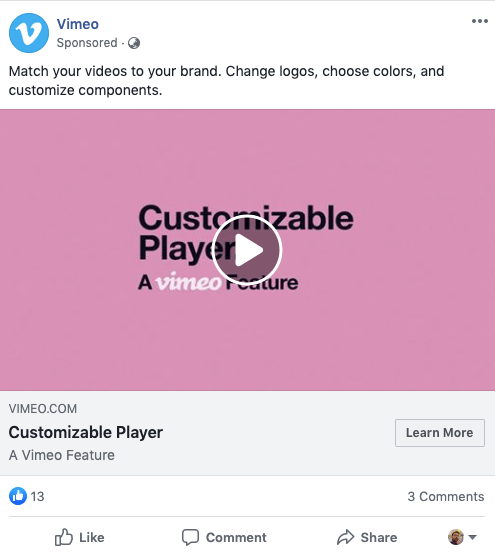
Facebook feed ads offer a prime spot for your standalone video advertisements. They easily blend into a user’s feed and seem organic, letting you reach your target audience in an authentic way. If made well, they can even seem like regular video content rather than promotional ads.
This means that if they’re visually appealing, they’re more likely to grab the user’s attention and be watched!
In-feed Facebook video ads are great for increasing your brand awareness and sparking potential customers’ curiosity. In order to do this, they should feature content that is captivating and attention-grabbing. The goal is to convince users to stop scrolling and watch your video.
How should you do this? By showing them how you can help them add value or solve a problem.
In-feed video ads are best suited for longer videos like explainers, product demos or influencer videos for example. Since they offer more creative time, they’re great for showcasing your product or service’s benefits and applications.
- Video ratio: 9:16 to 16:9
- Recommended resolution: Upload the highest resolution available
- Max size: 4GB
- Minimum length: 1 minute
- Maximum length: 240 minutes
- Text: 125 characters
- Headline limit: 25 characters
2. In-stream Video Ads
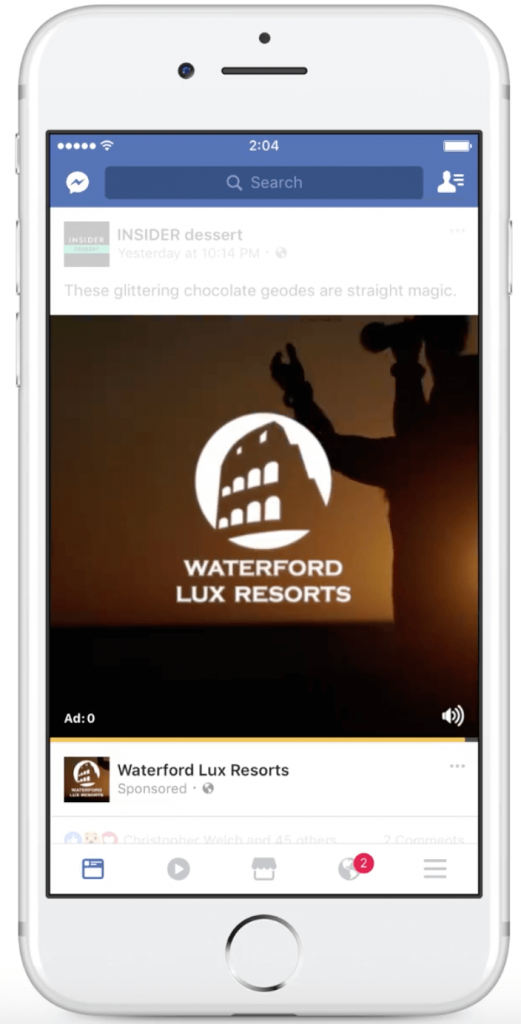
Not to be confused by feed ads, in-stream Facebook video ads are 5 to 15 second long and non skippable. These ads are delivered mid-roll for News Feed videos and either pre or mid-roll on platforms like Facebook Watch.
Mid-roll in-stream video ads usually appear around 60 seconds into a video. At this point, viewers are likely already engaged in the native video and are watching it with sound.
This means that short, digestible and interesting video ads work as great ‘commercial breaks’ for viewers.
Also, since users opt to watch the video in the first place, they’re more likely to want to complete it. But in order to continue watching the video, they must first watch your in-stream ad entirely.
This means more video views and engagement for your ad! In fact, according to Facebook, more than 70% are viewed to completion and most with sound on.
Just like with any other ad placement, Facebook enables ad targeting for in-stream video ads to reach the right audience. If you’re concerned about your associating your brand with sensitive topics, you can also exclude your ads from specific content. This prevents them from appearing on content labeled “debatable social issues” or “mature”, for example.
Specs
- Video ratio: 16:9 to 19:6, but 16:9 is recommended
- Recommended resolution: Upload highest available resolution
- Max file size: 4GB
- Video length: 5 to 15 seconds
- Video sound: optional, but highly recommended
3. Facebook Marketplace Video Ads
Facebook Marketplace is a hub to buy and sell items with other users in your community.
Facebook Video ads placed here have the advantage of targeting people with purchase intent. They’re exclusively shown to users browsing Marketplace and those who are looking to buy a product or service.
This means they generally have higher conversion rates and sales than feed videos or Stories.
Even though their reach is more limited than News Feed video ads, they have another edge. Since Marketplace is dominated by images, dynamic video advertisements are guaranteed to stand out and grab users’ attention.
This means more video views and attention for your content!
Marketplace is used for items that are bought and sold locally, so marketers should ideally keep a local focus in mind. This ad placement is ideal for locally - focused goods and services, especially those in the home, gardening, rentals and vehicles industry.
At the same time, content marketing ads may not perform as well as product related ads on Marketplace. Video ads promoting blog content, for example, might seem misplaced. It’s better to stick to advertising products that consumers are actively looking for.
- Video ratio: 9:16 to 16:9
- Recommended resolution: Upload the highest resolution video available
- Max file size: 4GB
- Minimum video length: 1 minute
- Maximum video length: 240 minutes
- Text limit: 25 characters
- Headline limit: 25 characters
- Link description: 30 characters
4. Carousel Ads
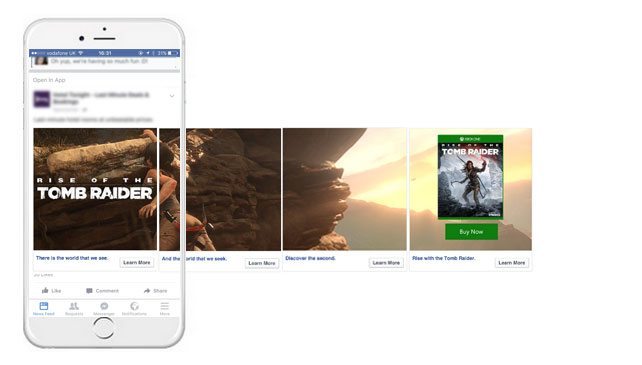
With this format, users can horizontally scroll through up to 10 videos in one ‘carousel’ ad. Each with its own call to action link!
Facebook video carousel ads are great because they offer a lot more creative space within a single ad. You can use them to show off a range of content, like highlight different products or specific details about one product.
If your brand offers services, carousel ads can be used to highlight the various services you offer and their features. Or, they can also be used to tell your viewers a story that develops across each carousel card.
Facebook carousel video ads are available on the following ad types:
- Facebook Feed
- Facebook Right Column
- Facebook Marketplace
- Facebook Instant Articles
- Minimum recommended video resolution: 1080 x 1080 pixels
- Minimum number of cards: 2
- Maximum number of cards 10
- Max video file size: 4GB
- Max video length: 240 minutes
- Text limit: 25 characters
- Headline limit: 40 characters
- Link description limit: 20 characters
5. Facebook & Messenger Stories Ads

Facebook Stories ads are full-screen vertical ads that appear as users are swiping through the Stories of accounts they follow. They last for up to 15 seconds or until the viewer dismisses them. These ads fit the same format as regular stories and keep the user’s experience seamless and uninterrupted.
Stories ads can be enhanced with fun and interactive features like special effects and filters. They also support CTAs through the ‘swipe up’ feature that automatically redirects the user to your website’s landing page.
Stories ads are short and snackable. This makes them perfect to share limited time offers and event promotions, for example. They’re also great for short teasers promoting your upcoming content or product launches, for example.
- Minimum resolution: 500 x 500 pixels
- Video ratio: 1.91 to 9:16
- For videos under 9:16, colored gradient bars are rendered above and below
- Max file size: 4GB
- Video length: 1 to 15 seconds
6. Suggested Video Ads
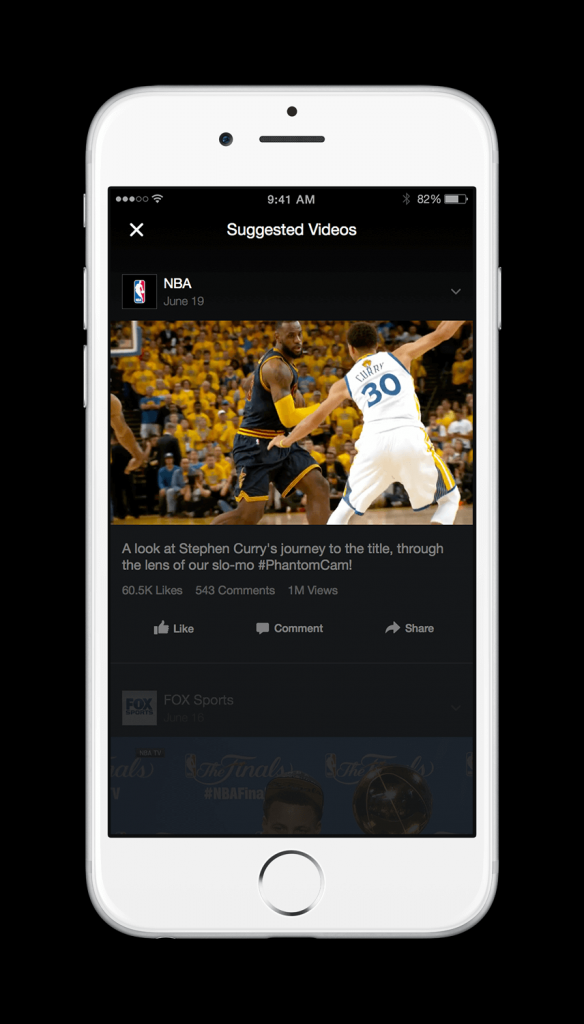
When a user clicks on a video from their News Feed, it opens in a player that includes other suggested videos. With this ad format, brands can insert video ads between these suggested videos.
Suggested videos automatically play after a viewer completes the video they clicked on. This makes them ideal to catch users’ attention and grow your brand awareness by increasing viewership.
- Video ratio: 16:9 to 9:16
- Single video ad
- Video duration
- Minimum duration: 1 second
- Maximum duration: 14460 seconds
- Video dimension
- Minimum width: 120 pixels
- Minimum height: 120 pixels
- Video size
- Maximum file size: 27306 MB
- Minimum file size: 1024 bytes
- Video aspect ratio
- Minimum aspect ratio: 100 x 400
- Maximum aspect ratio: 400 x 100
7. Collection & Instant Experience Ads (IE)
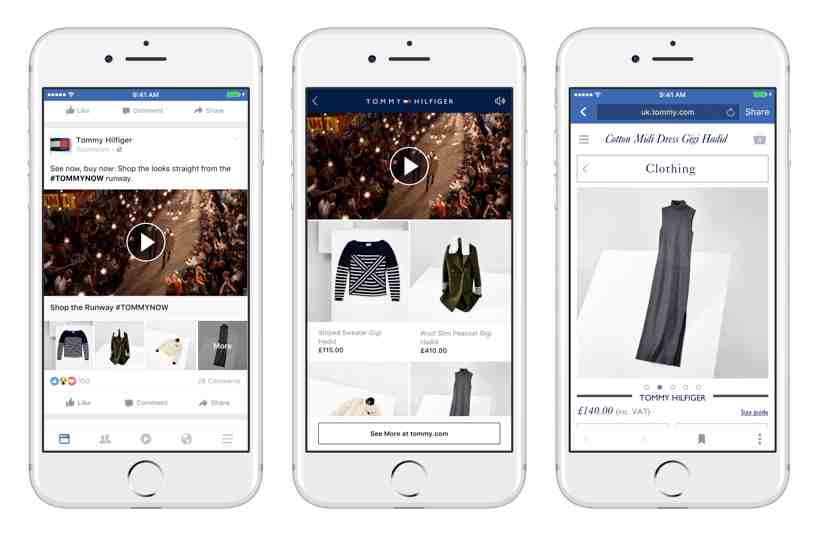
‘Collection’ is a Facebook ad format that enables users to discover, browse and shop products from their mobile device. IE ads combine rich media content with direct response marketing to create an immersive and memorable user experience.
The experience starts off with a regular cover video and 4 products displayed below it. When a user clicks on the call to action, they’re launched into the actual instant experience ad.
This is a full-screen interactive product catalog that lets users browse products and place orders. All without ever leaving Facebook! It’s perfect for generating conversions and encouraging users to purchase your products and services
- Minimum recommended resolution: 1200 x 628 pixels
- Max video size: 4GB
- Max video length: 120 minutes (recommended less than 2 minutes)
- Text limit: 90 characters
- Headline limit: 25 characters
Best Practices to Optimize Facebook Video Ads
Social media video marketing doesn’t have one clear cut formula, because all social platforms work differently.
Granted, there are definitely some similarities between Instagram and Facebook. But Facebook manages to set itself apart through some of its key features and characteristics.
This means you need to tailor your video marketing strategies to match the platform’s requirements.
So without further ado…
Regardless of the ad format, these 16 Facebook video ads best practices will optimize your Facebook video ads and increase their effectiveness.
1. Make the first 3 seconds count
In case you haven’t heard, humans now have a shorter average attention span than goldfish.
Yes, you read that right.
It was recently found that the average human being today has an attention span of 8 seconds. Couple this with the fact that users tend to scroll through their feed really quickly and you have yourself a problem.
If your video isn’t engaging enough from the get-go, chances are that potential customers are scrolling right past it.
The best way around this is to make the first few seconds of your video really count. In fact, viewers who watch the first 3 seconds of a video are more likely to finish it. So make sure these initial seconds are captivating and attention grabbing and make users stop scrolling. Even without sound.
Check out this Facebook video by food and beverage brand, Knorr, for example. The first three seconds of the video show a woman feeding something to a blindfolded man. This instantly sparks the viewer’s curiosity, and the question “Can flavour help you find love” keeps them hooked.
Knorr connects its product with human emotion to help the audience relate to its brand. The video is real, authentic, captivating and doesn’t over-sell the product. Also, Knorr mentions its brand name early on, so viewers can easily identify it.
One study suggests that consumers are 23% more likely to remember a brand name shown within the first 3 seconds of the video.
By leaving branding for later, you risk losing customers who don’t stick around till the end. This would be terrible, especially if your video marketing objectives were to increase brand awareness and conversions.
2. Use captions to increase view times by 12%
Thanks to autoplay, when a user is scrolling through their feed or stories, videos don’t automatically play with sound. That’s probably why over 85% of Facebook videos are watched on mute.
This means videos that rely on sound to catch the viewer’s attention or convey their message usually get ignored.
The sad reality is, consumers love content that engages them with minimal effort on their part. People watch videos that catch their attention without extra work, and it takes a lot them to actually press ‘unmute’ on video ads.
But don’t worry, the solution is simple.
Just keep things as visual as possible. Ensure that your video doesn’t require sound to be understood. Instead, make the best use of visual elements and storytelling to draw in viewers and keep them engaged.
If your video does have sound, always make it a point to include subtitles or closed captions. Not only do captions increase views by 12% and shares by 15%, they also help make your video more accessible. This means they can reach a wider audience and increase your brand awareness.
Facebook makes subtitling super easy with its option to automatically generate captions for your videos. Just remember to finetune and review them before you publish!
Check out this Facebook video ad campaign by ‘Always’. It connects with the brand’s target audience by starting a conversation about gender bias in emojis.
The video is effective and delivers a powerful message with supporting stats. The best part? It’s super accessible because of its subtitles.
3. Optimize CTA placement for maximum engagement
CTAs are great because they directly invite viewers to engage with your brand by taking a specific action. The problem is, even though your Facebook video ad has a CTA button, your viewers might not be clicking it.
This means you might want to prompt users to take an action and actually press the CTA button during your video. The best time to do that? Bang in the middle of your video.
If your video starts with a CTA, you risk losing viewers because your content seems overly self-promotional. It’s also not exactly a great way to grab your audience’s attention. It’s best to make sure that the beginning of your video acts as a hook, captivating your audience.
By placing a CTA at the end, you’re losing out on everyone who doesn’t watch the whole thing.
This is why CTAs strategically placed in the middle of an ad are optimum for encouraging your audience to take action. Mid-roll CTAs even have a higher conversion rate of 16.95%! In comparison, CTAs at the start have a rate of 3.15% and end have 10.98%.
4. Create and Optimize Thumbnails
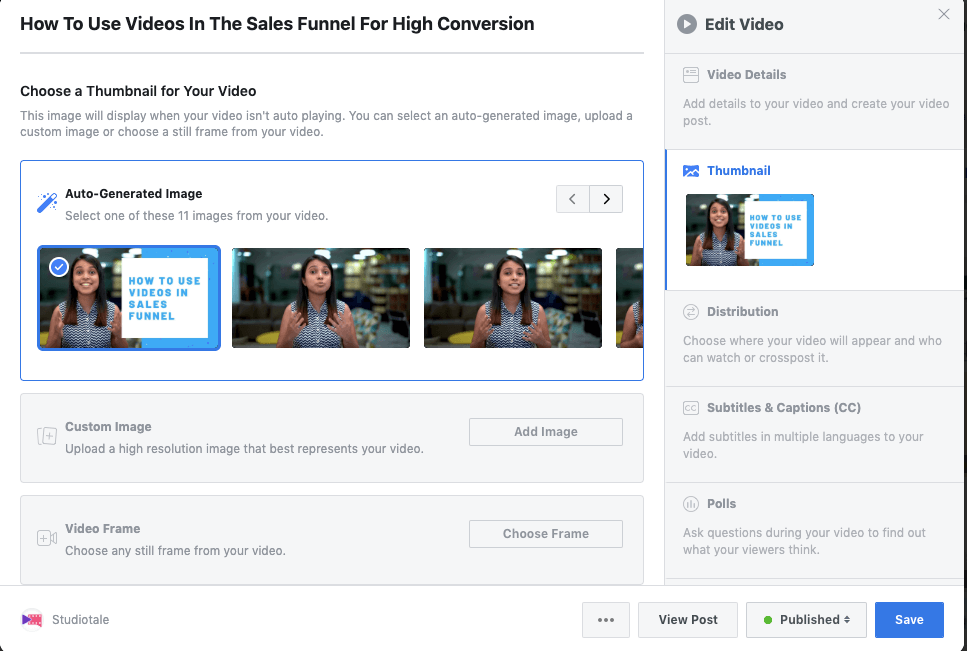
Facebook offers users the option to opt out of autoplay, and a lot of people take advantage of it. This creates a huge problem for brands because video ads don’t automatically play as users are scrolling through their feeds.
This means brands need to work harder to convince users to take the action and watch their video ads. But what is the best way to do this? By making interesting, captivating and relevant video thumbnails.
Thumbnails are super important because they form a user’s first impression of your video by making it stand out. They’re one of the main factors that decides whether or not a user watches your video and engages with it.
When you upload a video ad to Facebook, you’ll automatically be given 10 thumbnails to choose from. You use one of these or upload a custom thumbnail with text or an interesting still from your video.
Just remember — Facebook videos that consist of more than 20% text may experience reduced delivery. So keep that in mind when designing your thumbnail!
5. A/B test all your ads
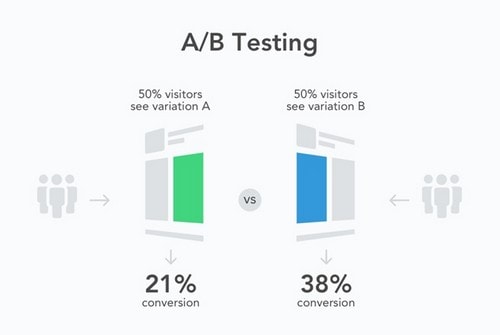
A/B testing allows you to test different versions of your ads to find out which works best. It’s a great option to analyse your social media video ads and optimize your future campaigns.
A/B testing can be used to test the same ad on two different audiences and see which ad performs better. This is great for helping you target your ads better. Or, you can test out two different ads on the same audience to see which content and style works better.
You can also use A/B testing to figure out which Facebook ad format works best for each type of content. For example, carousel ads might work best for product launches while stories work better for short, captivating ads.
Essentially, A/B testing is great for helping you answer questions like:
- Which message resonates the most with your audience?
- What types of content generate the most engagement?
- Which ad format has the most comments, likes or shares?
- Which call to action has the highest conversion rate?
- Which section of your target audience prefers a certain ad?
Just remember, when A/B testing you should only change one variable at a time. Try playing around with these to see how you can better optimize your ads:
- Creative
- Audience
- Placements
- Product sets
Facebook recommends to let your test run between 3 to 14 days, with 4 days being the ideal amount.
6. Optimize title and description
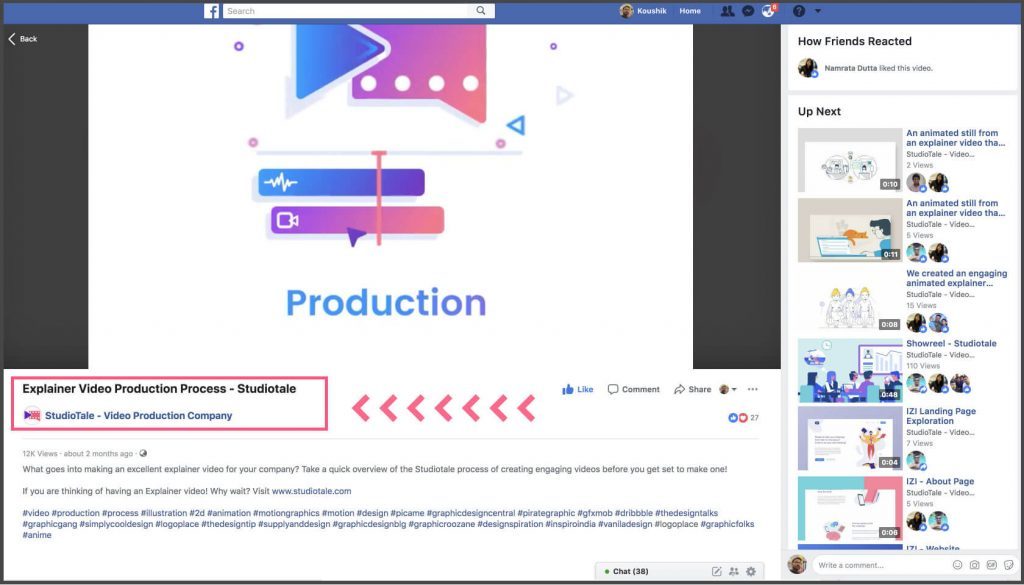
Aside from visuals and thumbnails, it’s also really important to optimize your Facebook video ad’s title and description. There are two main reasons for this.
The first is that catchy and clickable titles encourages users to watch your video. This is especially important because a lot of users disable the autoplay feature on Facebook. This means your video’s title plays a crucial role in attracting attention and increasing video views.
Your title should be concise, informative, catchy or funny — whatever works best for your brand and message.
Your video ad’s title and description should also include relevant keywords. These are super important because they feed into Facebook’s targeting algorithm and make your videos more search friendly.
7. Optimize landing pages for mobile
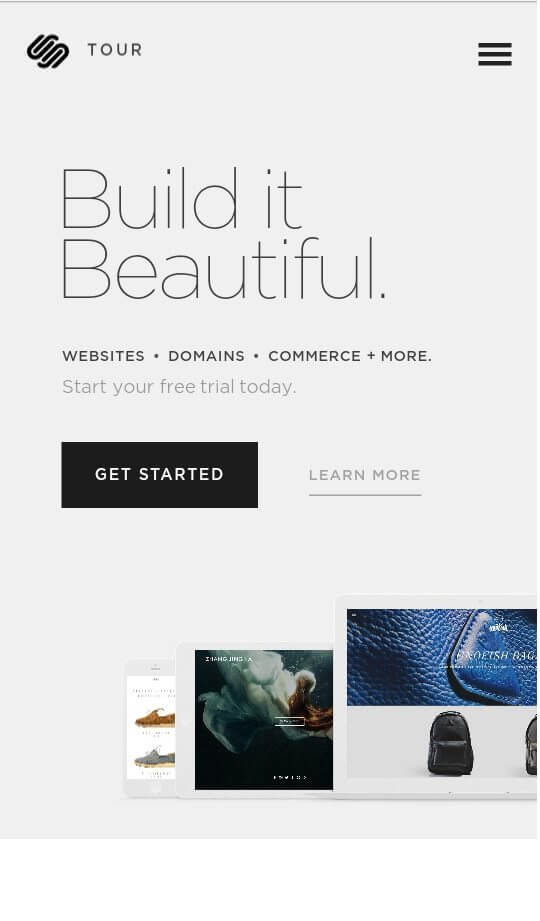
If your video ad’s CTA leads to a landing page, you need to ensure that it is optimized for mobile.
96% of Facebook users browse the app through their smartphones, so mobile friendly landing pages are key to securing conversions. In fact, you want to ensure a mobile-friendly user experience from start to finish for all Facebook video marketing campaigns.
Video ads have the potential to generate a lot of sales and the highest CTR of all digital ad formats. This means the landing pages they link to need to be optimized and accessible.
Here are a couple tips to keep in mind to make the mobile landing pages that convert:
- Keep it simple and minimalistic. Strip away everything that doesn’t need to be there and focus on your call to action.
- Focus on the benefits of your product or service and be specific.
- Include a sign-up form and keep it short and concise.
- Include testimonials in the form of videos or quotes to convert hesitant customers.
Take a look at this great example by Squarespace. Their desktop landing page is simple, minimalistic and effective with a clear CTA.
The mobile version is even more minimalist and only includes necessary elements. It’s easy to navigate and optimized for a seamless mobile experience.
It’s also essential that they matches your user’s Facebook experience. There’s nothing worse than having a visually stunning video ad that leads to a dysfunctional or unattractive landing page.
8. Post natively
This one should be a no brainer, but we can’t possibly stress it enough.
Upload your Facebook video ads natively!!!
Apart from capturing viewers’ attention, native videos also get 8x more comments than videos posted through Youtube or Vimeo. They also have 86% higher reach and receive 168% more interaction than videos from third-party sources.
Why? Because Facebook’s algorithm automatically prioritizes native videos, so they’re more likely to be seen by default. Also, by sharing Facebook video ads natively, you have access to targeting, optimizing and analytics tools offered by the platform.
So the bottom line is…
Native videos = more views, engagement and interaction!
9. Increase viewership by going all natural
There’s one thing you should always keep in mind when making social network video ads.
Make sure your ad doesn’t look like an ad.
Why? Because ads that seem overly self-promotional can come off as spammy and put customers off. This means valuable customers will be more likely to scroll past your ad and ignore it. Or even worse, mark it as irrelevant.
Try to make sure your video ads seem as organic and natural as possible. They should blend in seamlessly with the posts your customers see from their friends and other accounts they follow. This makes them far more likely to stop scrolling and interact with your content.
Millennials make up a lot of social media users. According to Eventbrite, 78% of them say they would rather shop experiences than ‘things’. So, inspirational and experience based video storylines are likely to get more video views and engagement.
Take this video by GoPro, for example. Inspiration based videos like this one work great for B2C products because they catch the user’s attention by showcasing thrilling and aesthetic visuals.
10. Target ads to reach the right people
One of the best ways to see instant higher engagement, visibility and interaction on your ads is by targeting them.
What does this mean?
It means customizing your ads so they align with certain marketing objectives and specific target audiences. And the best part is that targeting your Facebook video ads is a piece of cake with Facebook’s ads manager!
Before you get ahead of yourself, it’s really important to know who your target audience is.
There are two ways to do this. The first is by using Facebook’s in-app analytic tools to see who your followers are. This lets you break down their demographics by age, gender and location.
Secondly, you should know what YOUR dream audience or ideal ‘buyer persona’ is. Tools like Hubspot’s ‘Make My Persona’ can be great to help you map this out.
After identifying your target audience, use Facebook’s ads manager to target your ad for three main audiences:
- Core audiences
- Custom audiences
- Lookalike audiences
Core audiences
Core audiences offer the most basic Facebook video ad targeting. They let brands target ads to users based on simple filters like age, gender, location and interests.
They also allow for behavioural targeting based on purchasing habits, occupations and events, for example. Connection targeting lets you target users who have connected to your brand’s page, app or events.
Core audiences can also be used to exclude certain audiences who might find your ads irrelevant. This lets you deliver your content exclusively to audiences who might be interested in it.
Custom audiences
Custom audiences are great for identifying and targeting “warm leads”. These are individuals who have already shown interest in your content and have interacted with your brand.
They include filters like website visits, followers and users who have downloaded your app or already exist in customer files.
Custom audiences can also be used to exclude people who are already familiar with your brand. If you’re promoting your blog to a certain audience, you can exclude people who already regularly read your blog. This saves you advertising expenses and lets you attract only new readers.
You can also create a custom audience based on video views. This lets you target content to viewers who have watched a certain duration of your videos in the past. This way you can reach users who are already interested in your brand.
This is also great for Facebook video ad campaigns with a series of related videos or storylines. You can use it to target your videos to users who watched the previous ones to create a comprehensive user experience!
Lookalike audiences
Lookalike audiences are a great way to find and reach new customers with similar traits to your existing audiences.
When choosing your source audience, we recommend only using your best custom audience files as a starting point. Just avoid narrowing your audience too much because this could make it difficult to reach people with many layered targets.
At the same time, don’t keep your audience too wide because the results might not be targeted enough.
Also, opt for target expansion when creating your lookalike audiences. This lets you reach users who are likely to convert, even if they may not be in your current lookalike audience.
11. Engage with your audience
Social media is nothing without being social, and this applies to brands too!
For your video advertisements to see maximum positive engagement, it’s really important to interact with your customers. Stories poll stickers, for example, are a great way to directly engage your audience by collecting responses to questions.
But it doesn’t end there.
Just like with regular social media content, monitoring how your followers interact with your ads is key. Make it a point to respond to customers’ comments by liking them and replying to appropriate questions and concerns.
The more you directly engage with your followers, the better the user’s experience will be. And a better user experience means better chances at sales!
In fact, running ads and then neglecting them can be very risky business. Customers often use comments to ask questions, share experiences and even debate prices. If you ignore these comments, you risk harming your reputation. You might give off the impression that your brand only wants to sell products rather than listen to customers.
12. Optimize ads by using the right marketing objectives
Apart from knowing who you’re targeting, you also need to select an objective for your Facebook ad campaign. At this stage, you need to be asking yourself:
- What are you hoping to achieve with your ads?
- What are your marketing objectives?
It’s important to choose appropriate objectives because they affect how your video is optimized and their cost. Facebook also uses the objective to show your ad to the people who are most likely to take your desired action.
The different Facebook ad campaign objectives available fall into three categories: awareness, consideration & conversions.
This is how you know which one to pick for your next ad.
Awareness objective
These are ideal for increasing your brand’s exposure and generating interest in your product and service.
- Reach: Used to maximise your brand’s and video ad’s visibility
- Brand awareness: Used to get your brand’s name out there and make customers familiar with your products.
The brand awareness objective also optimizes for ad recall lift. This is an estimate of how many people recall seeing your ad within two days. It’s usually more effective than ‘reach’ because it measures whether or not users actually remember your brand.
Consideration objective
Consideration objectives are ideal for making potential customers more aware of your brand and inviting them to take a particular action.
- Traffic: Used to drive people to your website, app or blog.
- Engagement: Used to encourage people to engage with your ad by liking, commenting and sharing it.
- App installs: Used to encourage more users to download your mobile app.
- Video views: Used to promote and increase viewership for video ads that convey a message or showcase your brand.
- Lead generation: Used to collect lead information from people interested in your business.
- Messages: Used to encourage users to start conversations with your brand to generate leads, drive transactions and answer questions.
Conversion objective
Conversion objectives encourage people interested in your business to purchase and use your products or services.
- Conversions: Used to increase conversions at the lowest possible cost and promote sales of your product or service.
- Product catalog sales: Used to showcase products from your catalog based on your target audience.
- Store visits: Used to reach people near your physical business and encourage them to increase in-store conversions.
13. Make sure your videos match your objectives
This one is pretty straightforward, but it’s still important.
As you already know, Facebook offers brands a bunch of different video ad formats. Which one you select when creating a video ad should depend on your marketing objectives and content.
Basically, after deciding video ad’s objective, make sure its format and content work well for that goal.
For example, if your objective is increasing video views, short and vertical Stories video ads might be your best bet. You want to create content that is quick, captivating and snackable for viewers to watch on the go.
If your goal is brand awareness and recall lift, visual video ads like in-stream videos or carousels would work well. Just make sure they’re eye-catching and reflect your brand’s personality and aesthetic.
Similarly, if your goal is to increase conversions and sales, we recommend collection and instant experience or carousel ads. These formats enable you to showcase your products to potential customers in a visual and interactive manner. And of course, with IE ads, users can purchase your products directly from the Facebook app.
14. Include user-generated content in ads
It’s no secret that user generated content (UGC) is a golden key for marketers. It’s known to be a great source of higher engagement, customer interaction and conversions.
In fact, 90% of customers say they trust UGC over traditional advertising. Also, posts featuring UGC have a 4.5% higher conversion rate than those without. Moreover, 53% of customers say that UGC is the content they most want to see from brands.
But this isn’t really surprising. In fact, you probably already knew all this and might even use competitions or giveaways to encourage UGC.
But let me ask you this. Are you re purposing user generated content for your Facebook video advertisements?
Maybe not.
Try using videos and images submitted by users through social media to create more organic and credible advertisements. They’re cost effective and help you create ads that seem more like regular, engaging content.
Rather than seeming overly self promotional, they have the power to relate better to potential future customers. It’s probably why they even have a 4x higher click rate than ads without UGC!
Check out this Facebook video ad by Adobe Spark, for example. Adobe uses videos created by users with its video editing tool to promote its features. What better way to promote its video creation tool than by showing it at work?
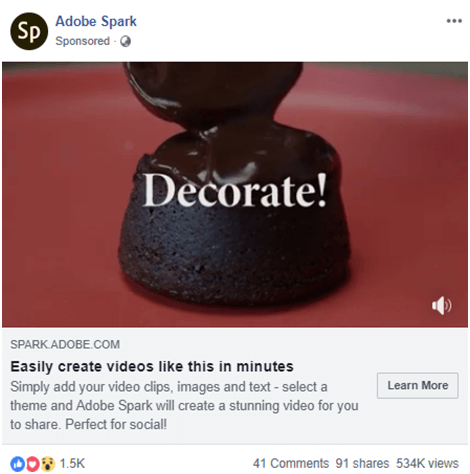
15. Understand and use the right KPIs
After understanding your marketing objectives, the next step is to select the appropriate “key performance indicators” (KPIs). These will be useful to measure and analyze the success of your video marketing campaigns.
The KPIs you pick are directly related to the marketing objectives of your campaign. They can pretty much be broken down into the same three categories as marketing objectives.
If your objective was to raise brand awareness, you might want to select a KPI like video views. You can even break this down into 3, 10 and 30-second video views to understand how users are watching your video. Or you can monitor ad recall lift, which measures how many people remember your ad after two days of seeing it.
If you had a consideration marketing objective, you can monitor web traffic with KPIs like the click-through rate. Similarly, if you want to drive sales and conversions, conversion rates and signups could be great for tracking performance.
16. Use Facebook lead ads
Facebook lead ads eliminate the pain points associated with customers filling out forms with their information.
How?
By letting customers stay on Facebook as they submit their lead form. This makes it easier for brands to generate leads and avoids the trouble of longer click-through journeys for users. It’s a win-win situation!
Instead of sending users to a landing page to fill out a lead form, lead ads let customers access offers directly through Facebook. They’re a quick, easy and efficient way for people to provide their information to businesses.
Oh, and did we mention? They also have a higher CTR for advertisers. Lead ads also generate high quality leads by attracting people willing to go through the effort of filling out a form.
Facebook lead ads look like regular video ads and have the same targeting and creative features. When a user clicks on the CTA, Facebook displays a form that is auto-filled with the customer’s information and voila! You’ve generated a new lead.
Great Examples for Facebook Video Ads
Now that we’ve equipped you with all the actionable tips you need, it’s time to make your own Facebook video ads. Remember… more often than not, the best ads are the ones that look the least like an ad.
Running a little low on inspiration? Don’t worry. We’ve got you covered.
Here we’ve compiled a list of some the best Facebook video ads out there. They’re perfect examples of engaging social media content to inspire your next campaign.
1. Chatbooks
This hilarious, engaging and relatable Facebook video ad by Chatbooks got a whopping 72 million views. And we can totally see why!
The video quickly gained popularity because it uses themes like family, motherhood and memories to relate to its audience. It’s also really funny. Humour (if used correctly) can be a great way to add charm to your video and hook viewers.
Oh, and Chatbooks’ use of subtitles throughout the video make it more accessible so viewers can enjoy it sound-off as well!
2. Grammarly
This emotional and effective video by Grammarly features the touching story of a user to showcase its product. The whole video feels natural and organic — it relates to viewers rather than overselling the brand.
The video is under two minutes and captures the audience’s attention with storytelling almost immediately. It’s also emotional and ends with an inspiring CTA, “Write the future”. The only thing this video might be lacking is captions, which could help increase its shares and views even more.
3. Peel
Rather than focusing on its product in an already saturated smartphone market, Peel uses video ads to showcase the people behind its brand. The video is short and does a great job of showing off the fun-loving and quirky personality of the brand.
It taps into the idea that people relate with people to engage with its audience. There’s also no critical dialogue, and on-screen text means this video can also be understood on mute!
4. The Beard Club
This Facebook video ad by The Beard Club is entertaining, unexpected and catches the audience’s attention from the get-go.
It’s a part of the brand’s campaign titled “Beard Motivation” aimed at encouraging men to give up shaving. As a brand that makes beard care and grooming products, it focuses on encouraging men to grow their beards.
Instead of just advertising their products, this video ad showcases razors of all shapes and sizes being destroyed violently. All with catchy classical background music. What’s not to love?
5. HelloFresh
HelloFresh is a food subscription service that teaches users how to make new and fresh meals every week.
This video is part of the “Rapid Recipes” series featuring quick instructions on how users can make meals using the product. Rather than overselling its brand, HelloFresh uses video ads to show customers how they can add value. It teaches customers how they can solve the problem of making home-cooked, fresh meals.
Also, the video and instructions are entirely visual. HelloFresh uses text and visual demonstrations to indicate quantities and steps, so it can be understood without sound!
6. Salomon
These inspiring Facebook video ads by Salomon combine stunning visuals with an inspiring message to hook the audience. The video helps users associate the brand with adventure and thrilling experiences, rather than over-selling a particular product. This helps viewers relate to the brand better and sparks their curiosity.
The gorgeous landscapes and adventurous action shots of skiers and runners grab the user’s attention and keep them hooked throughout. Also, rather than an aggressive product-related CTA, Salomon invites users to “join them” and become a part of the sports community.
7. Purple
This video ad by Purple has over 138 million views on Facebook, and for good reason. Its punchy and intriguing title, “How to use a raw egg to determine if your mattress is awful” immediately catches the user’s eye.
The video itself is entertaining, short and informative. Purple manages to set itself apart from other mattress brands in a fun and innovative way. It shows how the “raw egg test” can prove how a mattress should cradle your body’s pressure points. The visual tests and comparisons are great because they act as testimonials to the product’s quality!
How Studiotale Can Help You

There you go! That’s everything you need to know to kickstart a successful Facebook video ad campaign.
Remember, sometimes the most effective ads are the ones that least look like it. Keep things natural and remember to be yourself! Use your ads to show off your brand’s personality and relate to your customers.
Looking for more tips and strategies? Subscribe to our blog here.
If you’re still unsure of where to start with your Facebook video ad or need guidance from a video expert, we’ve got you covered.
Simply reach out to Studiotale and leave the rest to us. As a leading startup video production company, we’d be happy to help.
Don’t hesitate! Start a conversation with us today :)
-2.png)




